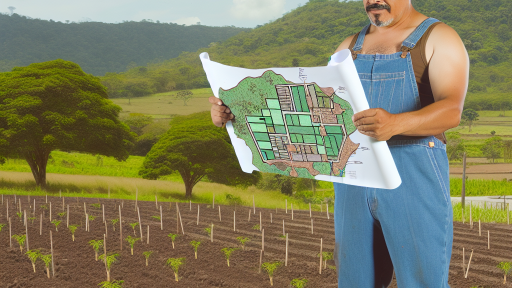Introduction to Carbon Sequestration and its Importance in Climate Change Mitigation
Carbon sequestration is a vital process for combating climate change.
It involves capturing and storing carbon dioxide from the atmosphere.
This process reduces the overall concentration of greenhouse gases.
Regenerative farming plays a key role in enhancing carbon sequestration.
Understanding Carbon Sequestration
Carbon sequestration occurs naturally and through human intervention.
Photosynthesis is a natural form where plants absorb carbon dioxide.
They store carbon in their biomass and release oxygen.
Conversely, regenerative farming techniques enhance this natural process.
The Importance of Carbon Sequestration
Mitigating climate change hinges on reducing atmospheric carbon levels.
Carbon dioxide is a significant greenhouse gas contributing to global warming.
Therefore, effective carbon sequestration lowers these emissions.
Furthermore, it enhances soil health by improving organic matter content.
Regenerative Farming Practices
Various practices in regenerative farming contribute to carbon sequestration.
These include cover cropping and reduced tillage methods.
Cover crops improve soil cover while preventing erosion.
Transform Your Agribusiness
Unlock your farm's potential with expert advice tailored to your needs. Get actionable steps that drive real results.
Get StartedMoreover, they enrich the soil with organic matter.
Reduced tillage minimizes soil disturbance, preserving carbon stocks.
The Role of Biodiversity
Biodiversity in farming systems boosts carbon sequestration potential.
Incorporating diverse crops enhances soil structure and health.
This diversity attracts beneficial organisms, further enriching the ecosystem.
As a result, the resilience of the farming system increases.
Community and Economic Benefits
Embracing regenerative farming offers economic advantages.
Farmers can potentially increase yields through improved soil health.
Moreover, communities benefit from sustainable practices and food security.
Engaging communities fosters awareness about climate change challenges.
Overview of Regenerative Farming Practices and Principles
Fundamental Concepts
Regenerative farming emphasizes the health of ecosystems.
This approach promotes biodiversity and sustainable land use.
Additionally, it focuses on rebuilding soil health through natural methods.
Key Practices
- Cover cropping enriches soil nutrients.
- Diverse crop rotation enhances soil structure.
- No-till farming minimizes soil disturbance.
- Composting returns organic matter to the land.
These practices work together to create a balanced ecosystem.
Ultimately, they contribute to carbon sequestration efforts.
Principle of Soil Health
Healthy soil is the foundation of regenerative farming.
It improves water retention and nutrient cycling.
Moreover, soil health supports vital microbial life.
This creates a thriving environment for plants.
Community Engagement
Regenerative farming encourages community involvement.
Farmers collaborate to share knowledge and resources.
This collective effort strengthens local food systems.
Furthermore, it fosters a connection between consumers and producers.
Long-Term Impact
These practices lead to sustainable agricultural systems.
Showcase Your Farming Business
Publish your professional farming services profile on our blog for a one-time fee of $200 and reach a dedicated audience of farmers and agribusiness owners.
Publish Your ProfileThey reduce reliance on chemical inputs and synthetic fertilizers.
This ultimately enhances the resilience of ecosystems.
In time, regenerative farming can mitigate climate change effects.
The Role of Soil Health in Carbon Sequestration
Understanding Soil Organic Matter
Soil organic matter is crucial for maintaining soil health.
It consists of decomposed plant and animal materials.
Additionally, it enhances soil structure and fertility.
This matter acts as a carbon sink, storing carbon from the atmosphere.
Importance of Soil Microorganisms
Soil microorganisms play a vital role in carbon sequestration.
They decompose organic material and release nutrients.
This process increases soil organic matter levels.
Healthier soils support diverse microbial communities.
Moreover, diverse communities enhance carbon storage capacity.
Practices to Enhance Soil Organic Matter
Various practices can improve soil organic matter.
Crop rotation can boost soil health significantly.
Cover cropping protects soil from erosion and adds organic material.
Reduced tillage minimizes soil disturbance and preserves structure.
- Add organic amendments like compost to increase nutrients.
- Implement agroforestry techniques to enhance biodiversity.
- Adopt no-till farming methods for better carbon retention.
Measuring Soil Health Improvement
Regular soil testing is essential for measuring health improvement.
Farmers can assess organic matter levels through simple tests.
Monitoring microbial activity reveals soil vitality.
Additionally, observing crop yields can indicate soil health progress.
Documentation helps farmers adjust management practices accordingly.
Find Out More: Reducing Chemical Inputs To Protect Soil Health
Case Studies: Successful Carbon Sequestration Projects Through Regenerative Farming
Overview of Regenerative Agriculture
Regenerative agriculture emphasizes restoring soil health.
It integrates practices that enhance biodiversity.
This approach focuses on carbon sequestration in the soil.
Pioneering Projects
Several projects have demonstrated effective carbon sequestration.
These initiatives showcase innovative farming practices.
They contribute significantly to climate change mitigation.
The Rodale Institute
The Rodale Institute leads research in regenerative practices.
It has documented significant carbon increases in soil.
They utilize cover crops and crop rotation strategies.
White Oak Pastures
White Oak Pastures highlights holistic grazing methods.
This farm improves soil structure and fertility.
As a result, it captures more carbon dioxide from the atmosphere.
Impacts on Local Communities
Successful projects also benefit local communities.
They create job opportunities in sustainable agriculture.
Additionally, they promote local food systems.
Future Implications
These case studies inspire global efforts in regenerative farming.
They highlight the potential of farming as a climate solution.
With further adoption, carbon sequestration can increase on a larger scale.
Showcase Your Farming Business
Publish your professional farming services profile on our blog for a one-time fee of $200 and reach a dedicated audience of farmers and agribusiness owners.
Publish Your ProfileSee Related Content: Using Cover Crops to Promote Biodiversity
Techniques for Enhancing Biodiversity in Regenerative Farming Systems
Integrating Crop Diversity
Integrating a variety of crops boosts soil health and biodiversity.
Crop diversity reduces pest and disease outbreaks.
Additionally, it supports different beneficial insects.
Farmers can practice intercropping and cover cropping.
These techniques improve the resilience of farming systems.
Enhancing Soil Health
Healthy soil fosters diverse microbial life.
This supports plant growth while sequestering carbon.
Farmers should apply compost and organic matter regularly.
Implementing no-till practices preserves soil structure.
This ultimately leads to better water retention and nutrient availability.
Creating Pollinator Habitats
Pollinator habitats are essential for ecosystem health.
Farmers should plant hedgerows and wildflower strips.
These areas provide food and shelter for pollinators.
Moreover, they promote increased crop yields through better pollination.
Encouraging biodiversity can enhance farm productivity significantly.
Using Livestock in a Regenerative Way
Integrating livestock improves biodiversity on the farm.
It creates natural fertilization and pest control mechanisms.
Rotational grazing can renew pasture lands effectively.
Farmers should focus on agroecological practices.
This includes managing herd sizes and grazing patterns.
Implementing Agroforestry Practices
Agroforestry combines trees with crop and livestock systems.
This technique enhances habitat for various species.
It provides shade and shelter for crops and livestock.
Furthermore, trees sequester carbon efficiently.
These practices increase the resilience of farming systems.
Monitoring and Adapting Practices
Regular monitoring of biodiversity is crucial.
Farmers should collect data on species presence and population sizes.
This information guides adaptive management practices.
Adjustments can lead to improved biodiversity outcomes over time.
Such an approach encourages continuous learning and improvement.
Delve into the Subject: Crop Rotation and Diversity: Key to Sustainable Farming

Monitoring and Measuring Carbon Sequestration
Importance of Monitoring
Monitoring carbon sequestration is crucial in regenerative farming.
It enables farmers to track progress and optimize practices.
Accurate monitoring ensures effective use of resources.
Moreover, it aids in verifying claims related to carbon credits.
Tools for Measuring Carbon Sequestration
Farmers utilize various tools to measure carbon levels.
These tools range from simple tests to advanced technologies.
- Soyl tests provide baseline information on carbon content.
- Remote sensing technology allows for large-scale monitoring.
- Field sensors offer real-time data on soil conditions.
Technological Innovations
Innovative technologies enhance carbon sequestration measurement.
For instance, AI and machine learning predict soil health trends.
Showcase Your Farming Business
Publish your professional farming services profile on our blog for a one-time fee of $200 and reach a dedicated audience of farmers and agribusiness owners.
Publish Your ProfileFurthermore, drones can capture detailed field images.
This data helps assess the effectiveness of farming practices.
Collaboration with Research Institutions
Collaboration with universities enriches data collection efforts.
Partnerships lead to improved methodologies for measuring impact.
Such collaboration fosters knowledge-sharing across the agricultural community.
Use of Carbon Accounting Software
Carbon accounting software simplifies tracking efforts.
It allows farmers to input data and analyze carbon credits.
These programs help in identifying practices that yield the best results.
You Might Also Like: Sustainable Techniques to Increase Farm Biodiversity
Challenges and Barriers to Implementing Regenerative Farming for Carbon Sequestration
Economic Factors
Economic limitations pose significant challenges for farmers.
Initial investments for regenerative practices can be high.
Farmers often face uncertainty in short-term yield reductions.
Morever, markets for regenerative products may be underdeveloped.
This can discourage farmers from making the transition.
Knowledge and Technical Skills
A lack of training restricts the adoption of regenerative practices.
Many farmers may not be aware of best practices for soil management.
Furthermore, complex techniques require specialized knowledge.
Access to educational resources can be limited in rural areas.
As a result, farmers struggle to implement effective strategies.
Policy and Regulatory Challenges
Current agricultural policies often favor conventional methods.
This creates a bias that hinders the growth of regenerative farming.
Incentives for carbon sequestration practices are often insufficient.
Furthermore, regulations may impose restrictions on innovative practices.
Policy changes are necessary to promote sustainable farming methods.
Cultural and Social Dynamics
Social norms can significantly impact agricultural practices.
Farmers may face peer pressure to conform to conventional methods.
Tradition often holds a strong influence over farming decisions.
Support networks for regenerative practices may be lacking.
This can limit the sharing of knowledge and resources.
Environmental Factors
Natural environmental conditions can complicate regenerative farming.
Variability in climate affects soil health and crop yields.
Extreme weather events can further disrupt farming practices.
This unpredictability adds an additional layer of risk for farmers.
Understanding local ecosystems is crucial for successful implementation.
Policy and Economic Implications
Supporting Farmers in Carbon Sequestration Efforts
Government policies play a crucial role in promoting carbon sequestration through regenerative farming.
These policies can encourage sustainable practices among farmers.
Firstly, providing financial incentives can boost farmers’ participation.
Grants and subsidies can offset the costs of implementing new techniques.
Tax breaks for farmers adopting carbon-friendly practices can motivate more engagement.
Moreover, educational programs can enhance farmers’ understanding of regenerative practices.
Showcase Your Farming Business
Publish your professional farming services profile on our blog for a one-time fee of $200 and reach a dedicated audience of farmers and agribusiness owners.
Publish Your ProfileThis knowledge empowers them to implement effective carbon sequestration methods.
Developing comprehensive training programs ensures farmers gain necessary skills.
Additionally, building strong partnerships with agricultural organizations can provide support.
These partnerships can facilitate knowledge sharing and resource access.
Investing in research and development is essential for advancing farming techniques.
Innovative methods can increase soil carbon storage capacity in various climates.
Moreover, policies should establish clear carbon offset programs to benefit farmers.
These programs enable farmers to sell carbon credits for their sequestration efforts.
Market Incentives and Consumer Education
Creating a market for carbon credits can provide significant economic opportunities for farmers.
This market can encourage more farmers to adopt regenerative practices.
Furthermore, consumer education can play a vital role in this transition.
Increasing awareness about the benefits of regenerative farming can drive demand.
Consumers who understand the value of carbon sequestration support sustainable practices.
In addition, promoting local food systems can enhance carbon capture efforts.
This approach minimizes transportation emissions and supports community resilience.
Establishing certification programs can distinguish carbon-sequestering products in the market.
Such certifications can influence consumer purchasing decisions towards sustainable options.
Cooperative policies and market incentives are critical for successful carbon sequestration.
Additional Resources
Soil Carbon Sequestration: Myths, Realities, and the Biden …
Regenerative Agriculture Practices | World Resources Institute




